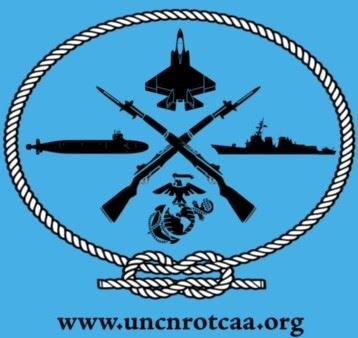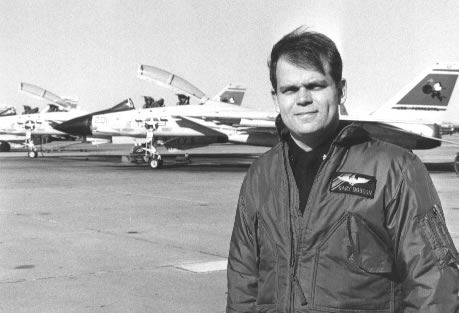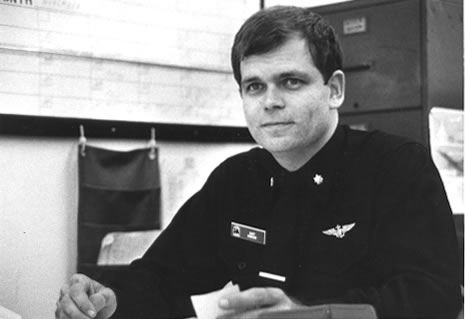- Home
- LCDR Gary Stephen Dobson Memorial
 |
|
LCDR Gary Stephen Dobson United States Navy
RELEASE NO. R-1505-85 OFFICIAL U.S. NAVY NEWS RELEASE UNIVERSITY OF NORTH CAROLINA GRADUATE FLIES F-14 TOMCATS By Brenda Starkey Photos by Chris Holmes Norfolk, VA. - For University of North Carolina graduate Gary Dobson the controls of an F-14 fighter aircraft are as familiar as the dashboard of his car. The 31-year-old Dobson is a pilot for Fighter Squadron 31, based at the Oceana Naval Air Station in Virginia Beach, Va. The 1976 Bachelor of Arts (mathematics) degree recipient loves his job. "The F-14 is the best jet the Navy's got," the Lieutenant Commander says. "you just feel like you're in control of the entire world. You feel really free. You get that feeling with any jet, but the F-14's more powerful because of the weapons system." The 20-ton Tomcat is capable of speeds twice the speed of sound and must land, traveling more than 170 mph, within 300 feet on an aircraft carrier. The plane's radar can simultaneously track up to 24 targets and guide as many as six Phoenix missiles to targets more than 60 miles away. Tomcats were in the headlines in recent years when they shot down two Libyan jets, participated in reconnaissance flights over Lebanon and Grenada and forced an Egyptian aircraft carrying terrorists to land in Italy. Dobson says the highlight of his Navy career was becoming a fighter pilot. That transition came after a 2 year tour of duty with Fleet Composite Squadron 10 in Guantanamo Bay, Cuba - a unit that fulfills both attack and fighter roles while training other Navy pilots and squadrons. Dobson says he flies 2 to 3 missions a week with the Tomcatters of Fighter Squadron 31, which amounts to about a quarter of his working time spent in the air. When he is not flying, Dobson is the squadron's Assistant Operations Officer in charge of planning how the Tomcatters' flight hours are spent. "The most challenging part of that job is handling the money," he says. "We are allotted over $1 million, most of which is spent on fuel for the planes." Dobson's squadron regularly deploys aboard aircraft carriers. The 9-year Navy veteran says he enjoys traveling with the squadron, but family separation is the biggest disadvantage of the sea service. Dobson says his wife, Cynthia, is an independent person and handles the separations well. She is employed as an accountant for a local firm and also cares for their two sons, Cliff, 9, and infant Andrew, when Dobson is deployed. "Family support is pretty important to a Navy career," Dobson says. "Back when I was deciding to stay in or leave the Navy, she said, 'Don't get out now.'" Dobson's visited nine countries in Europe and the Caribbean since completing flight training in 1977. "I enjoy being able to see other cultures and to understand their lifestyles and priorities," he says. Traveling isn't new to Dobson who father is a retired Navy Captain. The older Dobson's career was as a Navy civil engineer, but the younger Dobson says his dad shows interest in his aviation career. "Whenever he comes to visit, he wants to come out and look at the airplanes," Dobson says. Dobson says he never thought about flying while he was growing up, but once he started flying with the Navy it became an important part of his life. Although he says he's not sure how long he'll remain in the sea service, Dobson is quick to rule out a career in commercial aviation. "I don't think commercial aviation would be any fun," the fighter pilot says, "They fly straight and level. Its' all taking off and landing." Dobson says the biggest challenge in naval aviation is night carrier landings. "My first carrier landing was a real startle," he says. "you stop so suddenly. I was dazed for 20 to 30 seconds after I landed - kind of shaky and numb. Daytime landings are a lot easier and a lot of fun, but night landings never become commonplace." Dobson says he's met a lot of friends during his career. "I've gained a lot of good experience," he says. I've also gained knowledge on how to work with people, how to direct and manage. "If I had it all to do over again, I'd have gone directly into fighters," he says, "but I'd still have gone naval aviation." (Brenda Starkey is a Navy journalist assigned to the Navy Public Affairs Center in Norfolk, Va.) If you have additional information or material (anecdotes, photos, etc.) about this alumnus, please contact our secretary. |

